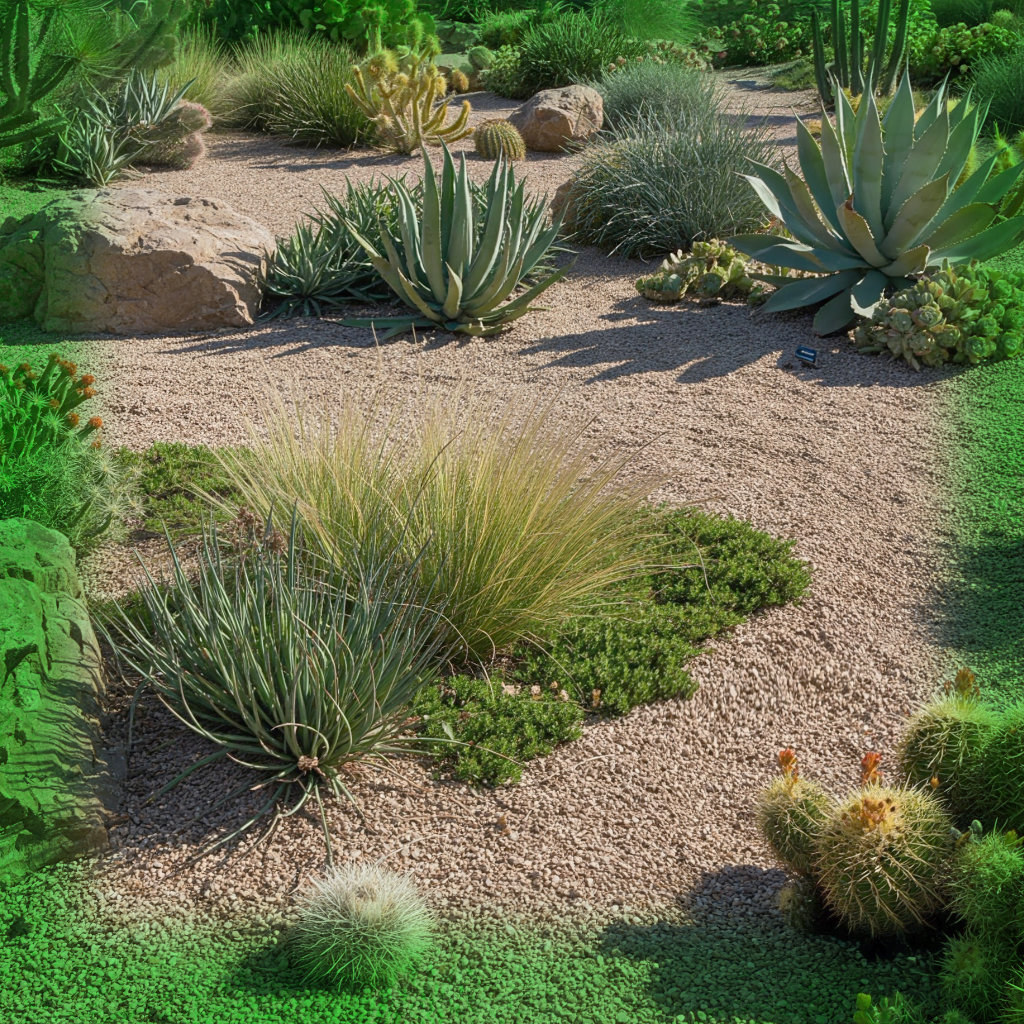Xeriscaping, a landscaping philosophy that emphasizes water conservation, is particularly well-suited to arid climates. By incorporating drought-tolerant plants, efficient irrigation systems, and thoughtful design, xeriscaping creates beautiful, sustainable landscapes that thrive with minimal water. This article explores the principles, techniques, and benefits of xeriscaping, offering a comprehensive guide to designing a water-wise desert landscape.
Understanding Xeriscaping Principles
Xeriscaping is built on seven core principles: planning and design, soil improvement, appropriate plant selection, practical turf areas, efficient irrigation, use of mulches, and regular maintenance. Unlike traditional landscaping, which often relies on water-intensive plants and lawns, xeriscaping prioritizes sustainability and resource conservation.
Planning Your Xeriscape Design
Begin by assessing your site’s conditions, including sunlight, soil type, and drainage. Create a base map to visualize your design, setting realistic goals for aesthetics and functionality. A well-thought-out plan ensures a cohesive and efficient landscape.
Soil Preparation and Improvement
Soil analysis is crucial for understanding its composition and drainage capabilities. Amend the soil with organic or inorganic materials to improve water retention and root growth. Healthy soil is the foundation of a thriving xeriscape.
Choosing the Right Plants
Native plants are the backbone of xeriscaping, as they are naturally adapted to local conditions. Incorporate drought-tolerant species like agave, yucca, and lavender. Succulents add color and texture, enhancing the visual appeal of your landscape.
Efficient Irrigation Systems
Drip irrigation delivers water directly to plant roots, minimizing waste. Smart irrigation controllers adjust watering schedules based on weather conditions, further conserving water. Rainwater harvesting systems can supplement your water supply.
Mulching for Moisture Retention
Mulch reduces evaporation, suppresses weeds, and regulates soil temperature. Organic mulches like wood chips decompose over time, enriching the soil, while inorganic options like gravel provide long-lasting coverage.
Zoning Your Landscape
Hydrozoning involves grouping plants with similar water needs together, optimizing irrigation efficiency. Create microclimates by placing shade-loving plants under trees or structures. Balance aesthetics with functionality for a harmonious design.
Hardscaping Elements
Rocks, gravel, and pavers reduce water usage and add visual interest. Pathways and patios provide functional spaces, while shade structures like pergolas offer relief from the sun. Hardscaping complements plantings, creating a cohesive landscape.
Lawn Alternatives
Replace traditional lawns with ground covers like creeping thyme or ornamental grasses. Artificial turf is a low-maintenance option, though it lacks the environmental benefits of living plants. Choose alternatives that suit your lifestyle and climate.
Wildlife-Friendly Xeriscaping
Native plants attract pollinators like bees and butterflies, supporting local ecosystems. Create habitats for desert wildlife by incorporating water features and shelter. A balanced landscape benefits both humans and animals.
Maintenance Tips for Xeriscaped Gardens
Seasonal care ensures your xeriscape remains healthy and vibrant. Prune plants to encourage growth and remove dead material. Manage pests naturally to avoid disrupting the ecosystem.
Water-Wise Gardening Practices
Water early in the morning or late in the evening to reduce evaporation. Use mulch and ground covers to retain soil moisture. Monitor soil moisture levels to avoid overwatering.
Incorporating Edible Plants
Drought-tolerant herbs like rosemary and thyme thrive in xeriscapes. Fruit trees such as pomegranates and figs are well-suited to desert climates. Design an edible xeriscape that combines beauty and functionality.
Xeriscaping on a Budget
Choose cost-effective plants and materials to stay within budget. DIY hardscaping projects can save money, while recycled materials add character. Xeriscaping doesn’t have to be expensive to be effective.
Xeriscaping for Small Spaces
Maximize vertical space with climbing plants like bougainvillea. Container gardening allows for flexibility in small areas. Even urban balconies can benefit from water-wise design.
Xeriscaping for Large Properties
Create distinct zones for different uses, such as entertainment areas and wildlife habitats. Manage water runoff on sloped terrain with terracing or swales. Large-scale hardscaping features like retaining walls add structure.
Seasonal Changes in Xeriscaped Gardens
Adapt your landscape to seasonal shifts by incorporating plants that thrive in different conditions. Prepare for winter by protecting sensitive plants and adjusting irrigation schedules.
Xeriscaping and Property Value
Xeriscaping can increase home value by reducing maintenance costs and enhancing curb appeal. Low-maintenance landscapes are attractive to potential buyers. Case studies demonstrate the financial benefits of xeriscaping.
Common Mistakes to Avoid
Overwatering defeats the purpose of xeriscaping. Poor plant selection and placement can lead to failure. Neglecting soil preparation undermines the entire design.
Xeriscaping in Community Spaces
Public parks and schools can benefit from xeriscaping, reducing water usage and maintenance. Community gardens with water-wise principles promote sustainability and education.
Xeriscaping and Climate Change
Xeriscaping mitigates drought by reducing water consumption. Sustainable landscaping practices lower carbon footprints. Long-term environmental benefits make xeriscaping a responsible choice.
Xeriscaping in Different Desert Regions
Adapt xeriscaping principles to the unique conditions of the Sonoran, Mojave, and Chihuahuan deserts. Each region presents specific challenges and opportunities for water-wise design.
Incorporating Art and Sculpture
Art and sculpture enhance the aesthetic appeal of xeriscapes. Use sculptures as focal points or blend art with natural elements for a harmonious design.
Xeriscaping for Fire Prevention
Fire-resistant plants and proper spacing reduce fire risks. Create defensible spaces around structures to protect property. Xeriscaping contributes to fire-safe landscapes.
Xeriscaping and Water Regulations
Navigate local water restrictions by adhering to xeriscaping principles. Take advantage of incentives for water-wise landscaping. Compliance with municipal guidelines ensures a successful project.
Educational Resources for Xeriscaping
Books, online courses, and local extension services provide valuable information. Nurseries specializing in native plants offer expert advice. Continuous learning enhances your xeriscaping skills.
Xeriscaping Success Stories
Homeowners and commercial properties have transformed their landscapes with xeriscaping. Inspirational projects from around the world demonstrate the versatility and beauty of water-wise design.
Future Trends in Xeriscaping
Innovations in plant breeding and irrigation technology are shaping the future of xeriscaping. The growing popularity of sustainable landscaping ensures its continued evolution.
Conclusion
Xeriscaping offers a beautiful, sustainable solution for desert landscapes. By embracing water-wise principles, you can create a thriving, low-maintenance garden that benefits both the environment and your property. Start your xeriscaping journey today and enjoy the rewards of a thoughtfully designed landscape.

